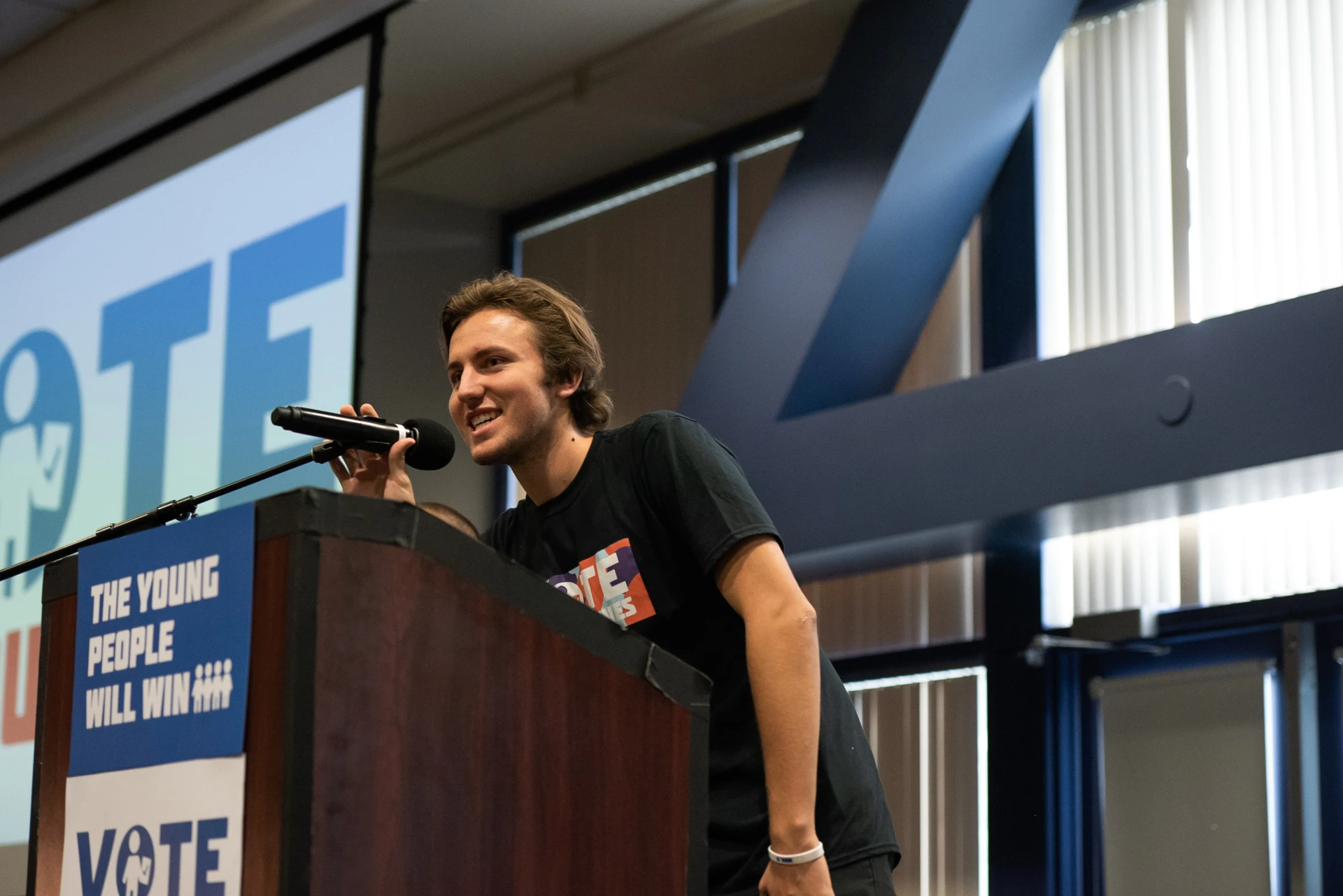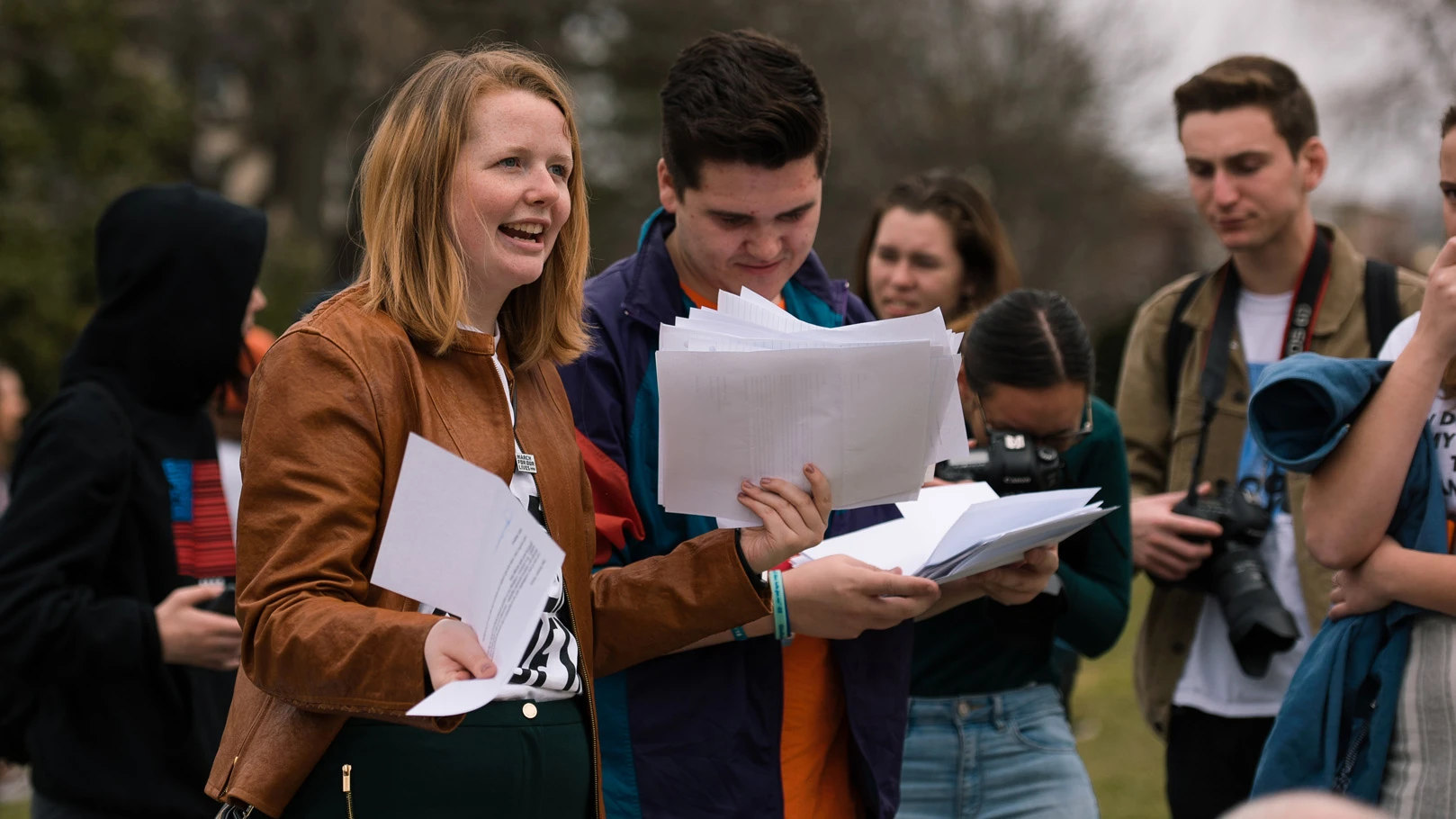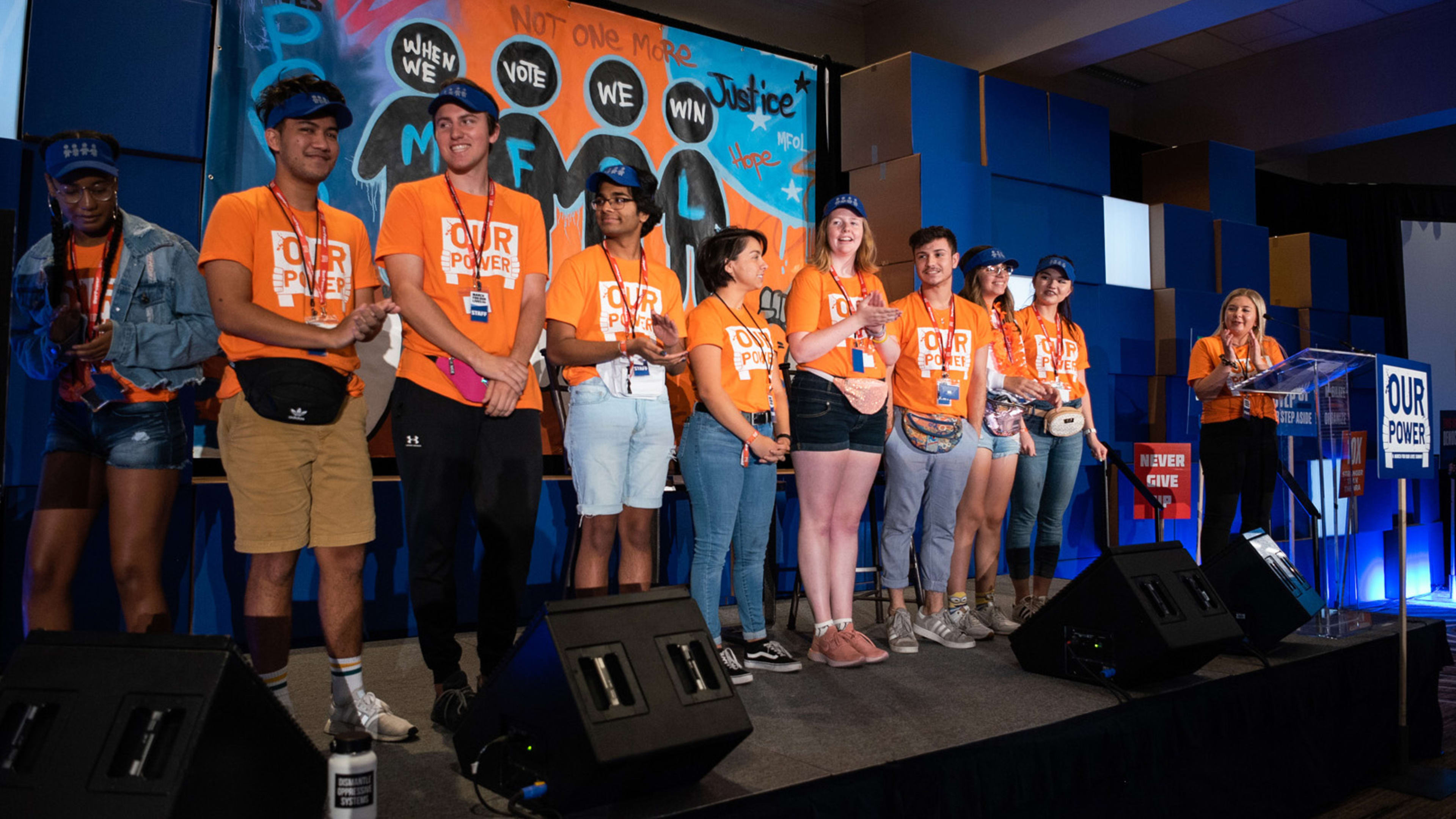On a summer weekend at the end of July, around 300 student volunteers from across the country, from Boston to Los Angeles, gathered at a hotel in humid Houston for a training summit. These young activists were expecting to receive a crash course in how to better serve their communities in combating gun violence. As Saturday’s activities commenced, the nightmare scenario they were preparing for became reality. News flooded in about a mass shooting at a garlic festival in Gilroy, California.
“It was a horrible reminder to everyone within the organization of why we’re in this fight,” says Perry Meade, March For Our Lives’ regional director for the Western states, who was in Houston at the time. The volunteers, rookies and vets alike, felt sad and sick as the details unraveled. Meade approached the California representatives to find they were already in the midst of organizing a response, deciding what actions to take to help the people of Gilroy.

Even by America’s dismal gun-violence standards, the past two weekends have been particularly awful. Shootings stunned communities in all corners of the country—from the California festival and a block party in Brooklyn to a Walmart in El Paso, Texas, and a bar in Dayton, Ohio.
When gun violence affects an entire nation, activist organizations such as March For Our Lives become vital forces in healing the pain and advocating for change. But it’s on the ground in local communities where the response to tragedies, and the change, happens. While David Hogg, Emma González, and other Parkland survivors led the national charge and became the faces of a new movement in TV appearances and at rallies, local chapters helped ignite a new push for gun reform behind the scenes. These community-based groups have existed from the start of the movement, when they mobilized across the country to march for their lives on March 24, 2018, a month after the mass shooting that claimed 17 lives at Marjory Stoneman Douglas High School.
While technology and social media played a key role in increasing the visibility of March For Our Lives, awakening a nation, and motivating young people to join the fight, the original founders knew that nothing was more powerful than face-to-face contact. “Technology sometimes does take away from that person-to-person connection, which is why we’ve dedicated a lot of our time to traveling to different communities, making sure people can feel us, not only on their phones, but also in person,” Jaclyn Corin, a founder of the movement, who’s heading to Harvard this fall, told Fast Company.
That’s why, beginning this year, the March For Our Lives (MFOL) movement underwent a structural transformation to empower the grassroots and facilitate communication between national and local layers. They carved the country into geographical regions, represented by appointed regional directors. Below them—figuratively, not hierarchically—lie the state boards, and the final layer comprises the local chapters—”where the real activism happens”—which exist in cities, colleges, and high schools across the U.S.
“We are not the anomaly,” Corin, 18, added of the passion of the original members. “There are thousands just like us, in every corner of the country, who care just as much about this issue and work day and night on making sure they’re bettering their community.”
Cultural differences, shifting tactics
Those are the young activists in 150 or so local chapters, a number that’s growing by the day. Los Angeles has several chapters, and Idaho is likely to open its first very soon. Ohio has a chapter in each of its major cities—one of which is in Dayton.
The Dayton chapter comprises about 10 members: “It’s a little smaller, but they’re definitely small and mighty,” says Linnea Stanton, 20, regional director for the Midwest. As soon as Stanton heard about the shooting outside Ned Peppers Bar, she reached out to ensure the safety of the local chapter, after which team members from across Ohio, all part of a mobile group chat, put heads together to decide how to help the community in need. Stanton, who attends Marquette University in Milwaukee, became the point of contact for other regional directors, and for external organizations willing to assist. Soon enough, Dayton, along with surrounding chapters in Cincinnati, Cleveland, and Columbus, had planned vigils in Ohio, and others were in the works for Illinois, Wisconsin, and Kentucky.

Meade, 20, the Western regional director and a student at UC Berkeley, says MFOL members in the Pacific states are naturally “super active” and that change can happen fast, given that those populations are “very accepting of more gun control.” It means the infrastructure of that MFOL region is already robust, with political and content teams already in place. Members can afford to spend less time actively persuading locals to take gun control seriously and instead focus more on passing legislation and raising funds.
Almost the opposite is true in the Southern states, which Meade oversaw until three weeks ago. “I come from Orange County, and even if we think we live in a conservative bubble, there’s a real culture shock in the South.” In Orange County, the idea of arming teachers is an explicit no-no, but in the South, where many believe the presence of more guns is a sign of safety, there has to be basic messaging about why guns in schools is not a good idea.
These cultural differences are the reason why regional and local chapters are so essential, in that they can tailor messaging to those communities in precise ways. Matthew Hogenmiller, 17, now regional director for the South, emphasizes that they have to be careful that their message doesn’t become misconstrued or altered, like the common trope that all reasonable efforts at gun reform are schemes to take away everyone’s arms.
Emphasizing outreach over moral rescue
They have to approach their task slowly and creatively. Past outreach methods have included art exhibits, concerts, and spots at SXSW, all of which also allow MFOL to stand out as a youth movement. “It’s easy to convince people after you have their attention,” Hogenmiller says.
A key value is not to be viewed as saviors parachuting in to morally rescue a community. “We try to avoid overstepping as much as possible,” he says. “We make sure we help people in the way that they want to be helped, not in the way we think they need to be helped.”
Although it’s not uncommon in California for 14-year-olds to be activists, Meade says, progress in the South can be sluggish. “People need the push. They need something to get them riled up.”
Regrettably, that push came in the form of tragedy in El Paso.
Though there isn’t currently an El Paso chapter, state reps teamed up with Texas Rising, a local social-justice organization also run by young activists, to take immediate action after the shooting, which claimed 22 lives. Together, they used social media to spread news of vigils, set up a P.O. box so people could send notes of condolences and love, and are working on an initiative to collect school supplies to send to the community. Many of the people at the Walmart that dreadful Saturday were shopping for school provisions— including Jordan Anchondo, the young mother who died saving her two-week-old baby from gunfire.
It’s often the case that it takes a tragedy to spike interest in gun reform. Since the shootings, there’s been a rise in sign-ups by people looking to join chapters or start new ones. Hogenmiller said he’s seen such a surge in interest that he expects a brand-new El Paso chapter to spring up in the next few days.
Still, it’s the South, and guns are so deeply embedded within the culture. So, while grassroots support is achievable, legislation is a bigger hurdle—and it takes complex political strategies to even have a shot at passing gun reform. Selina Eshraghi, the director of Austin’s local chapter, says a huge focus is getting out the vote and flipping severely gerrymandered districts. Though Austin is a liberal enclave, the city has been “cracked” into various surrounding conservative districts, meaning the liberal capital has little legislative impact. Even an initiative that Texas MFOL worked hard on and thought could pass—a resolution to ban guns on airport tarmacs—was vetoed by Governor Greg Abbott.
“We know there’s certain legislation that’s not going to pass in Texas, and that’s just the truth of the matter,” Eshraghi says. “It really is about putting our energy in the right places.”

Again, it’s about tweaking tactics. Instead of pushing for universal background checks, local MFOL chapters advocated for a “defensive approach” to curb school violence, by allocating more money to school counselors. They also mobilized 5,000 high school students and set up 50 voter registration drives for the 2018 midterms, which helped to flip Phoenix’s embattled Maricopa County, famous for its controversial tough-on-crime, anti-immigrant former sheriff, Joe Arpaio.
When violence in communities of color gets ignored
This is not to say that it’s necessarily much easier to effect change in more liberal areas of the country. While the Northeast has tighter gun laws, violence in its urban areas is regularly sidelined when it comes to media attention. “Local gun violence, concentrated in communities of color, is being ignored,” says Vikiana Petit-Homme, 17, regional director for New England and New York.
On July 28, the same day as the Gilroy gunfire, there was a shooting in Brownsville, Brooklyn, in which a gunman opened fire during an annual Old Timers Day, a community celebration dating back to 1963. It was barely reported, even within New York City, a familiar story when the victims are black. While mass shootings are on the rise, “communities of color have been talking about gun violence for a really, really long time,” says Petit-Homme, who just graduated from high school. “These chapters really act as their own sort of organizations because they face the issue of gun violence very differently.”
As the El Paso and Dayton shootings unraveled on TV and Twitter, there was deathly silence in the media as Chicago experienced its bloodiest weekend of gun violence all year, leaving seven dead and 52 injured from 32 separate shooting incidents. According to the Chicago Tribune, there have been 300 gun homicides in Chicago this year so far.
“There definitely is a different approach when it comes to organizing and discussing gun violence in Chicago, because there are so many factors,” says Stanton, whose Midwest region includes Illinois. As a start, local chapters have planned a vigil in Douglas Park, where 7 were wounded over the weekend near a playground. Over the long term, chapters want to identify ways to gain the attention of the national media.
Local chapters also work to influence federal politics, especially as states get ready to vote in the Democratic primaries. “We really want to make sure gun violence is one of the top issues for 2020,” Petit-Homme says. “Because it’s killing too many people not to be.” MFOL is holding a presidential forum dedicated to gun violence on October 2, memorializing the second anniversary of the Las Vegas massacre, which claimed 58 lives. At the time of publication, eight presidential candidates have registered to attend, including Beto O’Rourke, a longtime El Paso resident who’s become vocal about the need for gun control, and Cory Booker, who’s detailed perhaps the most ambitious and in-depth gun-reform policy, including a national licensing requirement.
MFOL doesn’t explicitly endorse candidates, but rather focuses on voter literacy and education on gun reform, in the hope that people will make informed decisions. At an Austin town hall later this month, they’ll invite opponents of Texas senator John Cornyn, who responded to the weekend’s shootings by tweeting: “Sadly, there are some issues, like homelessness and these shootings, where we simply don’t have all the answers.” MFOL is also pushing for the U.S. Senate to pass various gun-control bills that are gathering dust on Majority Leader Mitch McConnell’s desk. The Kentucky chapters are planning a vigil outside McConnell’s Louisville residence, where he’s staying during Congress’s recess, as a means of pressure.
In every case and at every level, this is a movement run primarily by high schoolers and college students. “Young people have a unique connection to gun violence in a sense that it’s something that we’ve always known and seen,” Petit-Homme says. This is a generation that’s grown up watching school shootings—the “lockdown generation” that’s become numb to bomb squads and SWAT teams entering their schools. The founders, after all, lost friends and loved ones forever on a Wednesday afternoon in Parkland.
Instead of creating despondency, it’s inspired urgency and optimism in these young activists, who are inspired even by snail-paced change. “There are so many people that care,” says Eshraghi, the Austin leader. “And, if anything, that will change the way our communities look at and handle and treat firearms. At least that has an impact even if I don’t get to see a tangible piece of legislation.”
Petit-Homme doesn’t hold back her buoyancy. “It’s crazy how much hope I have. It’s actually crazy,” she says. “Whenever you’re in a room with so much energy, and so many young people all around this one shared purpose, there’s no way you can’t be as hopeful as I am.
“I have no doubt that we can do this.”
Recognize your company's culture of innovation by applying to this year's Best Workplaces for Innovators Awards before the extended deadline, April 12.
